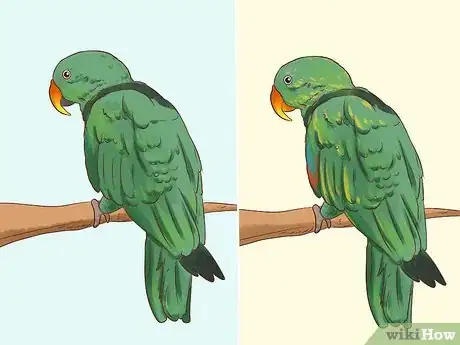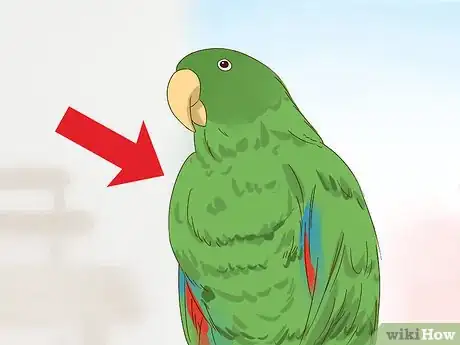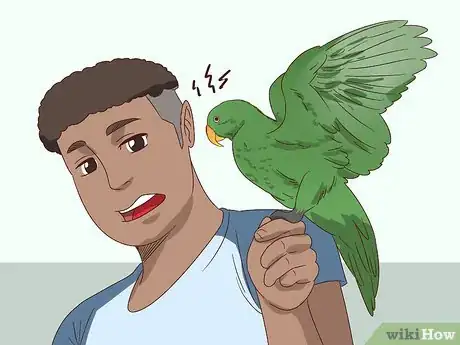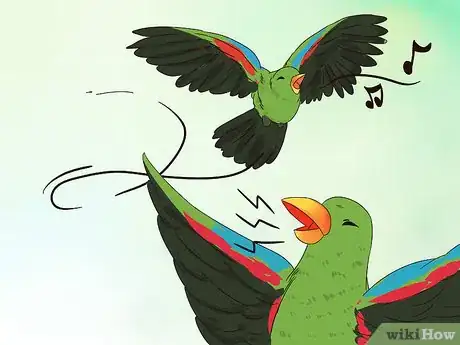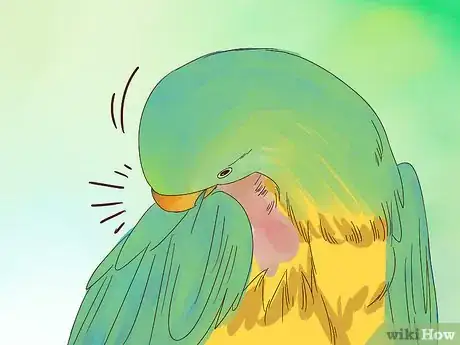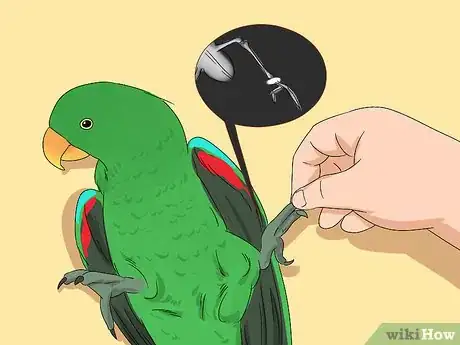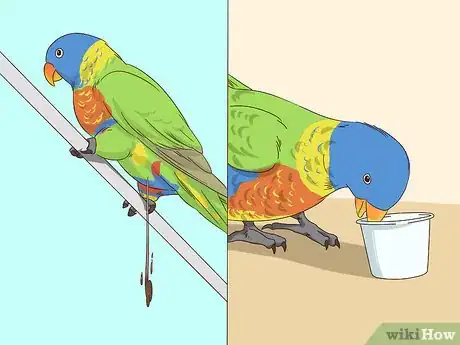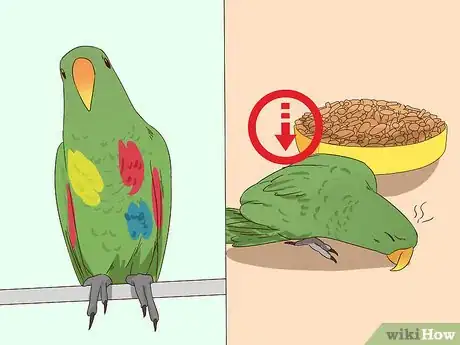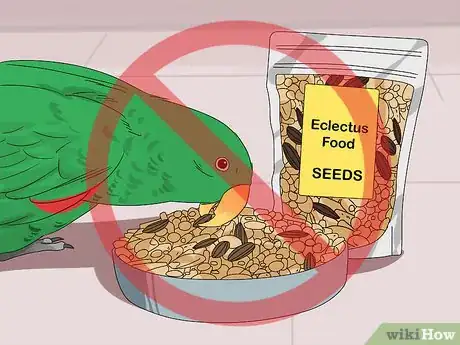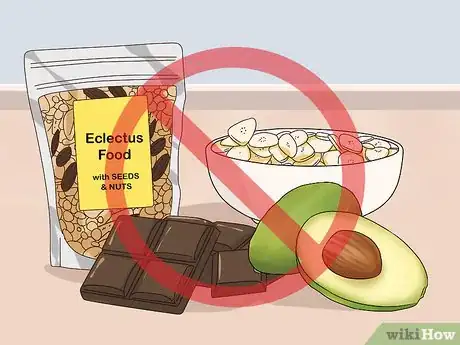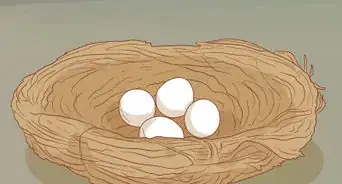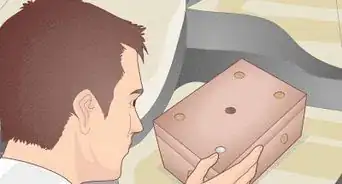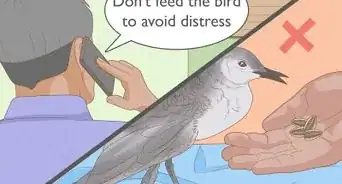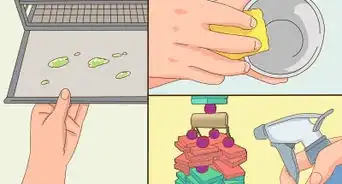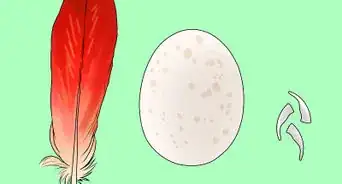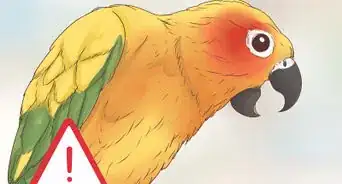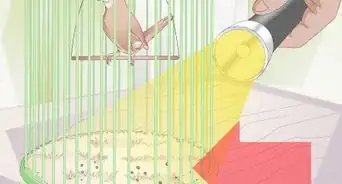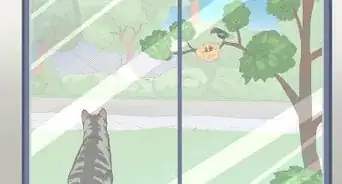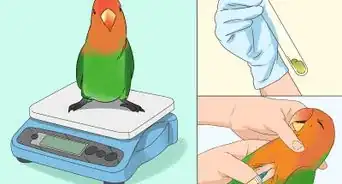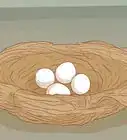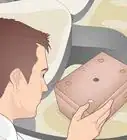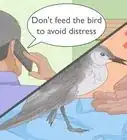This article was co-authored by Pippa Elliott, MRCVS. Dr. Elliott, BVMS, MRCVS is a veterinarian with over 30 years of experience in veterinary surgery and companion animal practice. She graduated from the University of Glasgow in 1987 with a degree in veterinary medicine and surgery. She has worked at the same animal clinic in her hometown for over 20 years.
This article has been viewed 25,652 times.
Eclectus parrots are beautiful and interesting birds that make great pets. However, because of their unique digestive tracts and dietary needs, they are prone to certain nutritional disorders. By familiarizing yourself with common disorders, watching for symptoms, and reviewing your parrot’s diet, you’ll be better able to spot signs of nutritional disorders in your eclectus. In the end, your bird will be healthier and lead a better life.
Steps
Identifying Common Symptoms
-
1Spot uncharacteristic changes in the color of feathers. Color changes are a common sign of nutritional disorders. Color changes in plumage may indicate liver problems that are connected to a nutritional deficiency.
- For instance, if your parrot has red feathers that suddenly turn green, this could be an indication of a nutritional deficiency.[1]
-
2Watch the bird’s breast development. Healthy eclectus should not have noticeable or large breasts. Since eclectus tend to add weight inside the body cavity first, the development of meaty breasts are an almost certain sign of obesity. This is likely related to some sort of nutritional problem or disorder.
- If you notice your bird becoming obese, you should re-evaluate its diet. In many cases, you’ll need to lower their consumption of pellets and increase their consumption of fresh fruit and vegetables.
- Likewise, if the bird's breast bone is very prominent, the bird is underweight and is not receiving adequate nutrition from the food or is not eating enough.
Advertisement -
3Watch for aggression. While aggression is a symptom of a variety of many conditions, it is also an indication of a potential nutritional disorder. Birds that act aggressive may not be getting all the vitamins they need to be healthy. In addition, they may be hungry.
-
4Look for signs of hyperactivity. If you notice your parrot has extra energy, is awake more than it should be, or is generally hyperactive, it might be experiencing a nutritional disorder of some sort.
- Evaluate your parrot’s diet and consider adding more fresh fruits and vegetables.
-
5Take note if your eclectus destroys its feathers. Birds that systematically tear out their feathers could have an underlying nutritional disorder. Watch for your bird picking at their skin, plucking their feathers, or having a loss of feathers of night or while you are not at home.
- Address loss of feathers by visiting your vet. In many cases, your vet will recommend altering the bird’s diet.
- Remember that there are many reasons for feather plucking, including nutritional disorders. You should take your bird to an avian veterinarian at the first sign of an issue for a proper diagnosis and treatment. An early diagnosis is important, as an established disorder will be harder to treat.
Looking for Common Disorders
-
1Watch for hypovitaminosis A. Hypovitaminosis A is a disorder that eclectus parrots get when they don't get enough vitamin A in their diet. The most common cause of hypovitaminosis A in eclectus parrots is an overconsumption of seeds. This is a very severe threat to your parrot's health. Some symptoms include:
- White patches on the mouth or tongue.
- Labored breathing
- Lack of appetite
- Nasal discharge
- Diarrhea
- Feather discolorations[2]
-
2Identify calcium and phosphorus imbalances. Like hypovitaminosis A, calcium and phosphorus imbalances occur when an eclectus parrot consumes too many seeds and grains. This results in an inability to digest and absorb calcium and phosphorus. Symptoms of calcium and phosphorus imbalances include:
- Weakness
- Osteoporosis
- Bone fractures
- Brittle eggs[3]
-
3Look for vitamin D imbalances. Like other nutritional imbalances, vitamin D problems reflect an improperly formulated eclectus diet. When an eclecctus has a vitamin D imbalance, their body will be unable to metabolize calcium properly. This will eventually result in the formation of kidney stones. Symptoms include:
- Excessive urination or inability to urinate
- Weakness
- Irritability
- Thirst[4]
-
4Identify liver problems. Due to their digestive system, eclectus parrots are at a higher risk of developing liver problems if they do not get proper nutrition. If caught early, liver problems could be minor. However, if underlying nutritional problems are not addressed quickly, they could endanger your bird’s life. Some symptoms of nutritional-related liver problems include:
- Abnormal feather color.
- Loss of appetite.
- Low energy.[5]
Reviewing the Bird’s Diet
-
1Provide the bird with a lot of fresh fruits and vegetables each day. Eclectus parrots need more fruits and vegetables than other types of parrots. Their diet should consist of about 80% fruits and vegetables. Without fruits and vegetables, they’ll suffer nutritional disorders. In particular, provide:
- Leafy greens.
- Colorful fruits like berries and citrus.[6]
-
2Give bird pellets only as a supplement. About 20% of your bird’s diet should be a quality bird food in pellet form. Bird food will provide some fiber, fat, and other nutrients that the birds may not get from fruits or vegetables. In addition, your bird will likely enjoy its pellets.[7]
-
3Do not put your eclectus on a seed-based diet. Seed-based diets are one of the greatest causes of nutritional disorders in eclectus. Because eclectus parrots have a different digestive system than other birds, they are unable to digest seeds. In addition, seeds do not provide the nutrition that eclectus parrots need to be healthy.
- Consider soaking bird pellets in water before serving them to your eclectus.
-
4Avoid certain foods. Your eclectus could suffer nutritional disorders if it consumes certain foods. These foods could cause kidney problems, liver problems, and other illnesses. Ultimately, you should only give your eclectus foods that its digestive system can properly process. Avoid:
- Foods with lots of sugar or salt.
- Processed foods.
- Bird food mixes with a lot of seeds or nuts.
- Foods that contain caffeine.
- Avocados.
- Chocolate.[8]
References
- ↑ https://www.beautyofbirds.com/eclectusdiseases.html
- ↑ http://www.peteducation.com/article.cfm?c=15+1835&aid=2054
- ↑ http://nilesanimalhospital.com/files/2012/05/nutritional-diseases.pdf
- ↑ http://nilesanimalhospital.com/files/2012/05/nutritional-diseases.pdf
- ↑ https://www.beautyofbirds.com/eclectusdiseases.html
- ↑ https://www.beautyofbirds.com/eclectusfood.htm
- ↑ https://www.beautyofbirds.com/eclectusfood.htm
- ↑ http://www.birdsnways.com/articles/efsep4.htm
About This Article
To spot nutritional disorders in your eclectus parrot, be on the lookout for color changes in the bird’s feathers. For example, a malnourished eclectus parrot may change from red to green. You should also keep an eye on the parrot’s breast. If it’s really round and meaty, your bird may be obese, while a narrow or bony breast suggests undernourishment. Additionally, check for behavioral symptoms, such as aggression or hyperactivity. Finally, see if your eclectus parrot is plucking at its skin or feathers. While feather pulling can have many causes, it is often a sign of a nutritional disorder. Read on for advice from our Veterinarian co-author about how to identify specific disorders!
